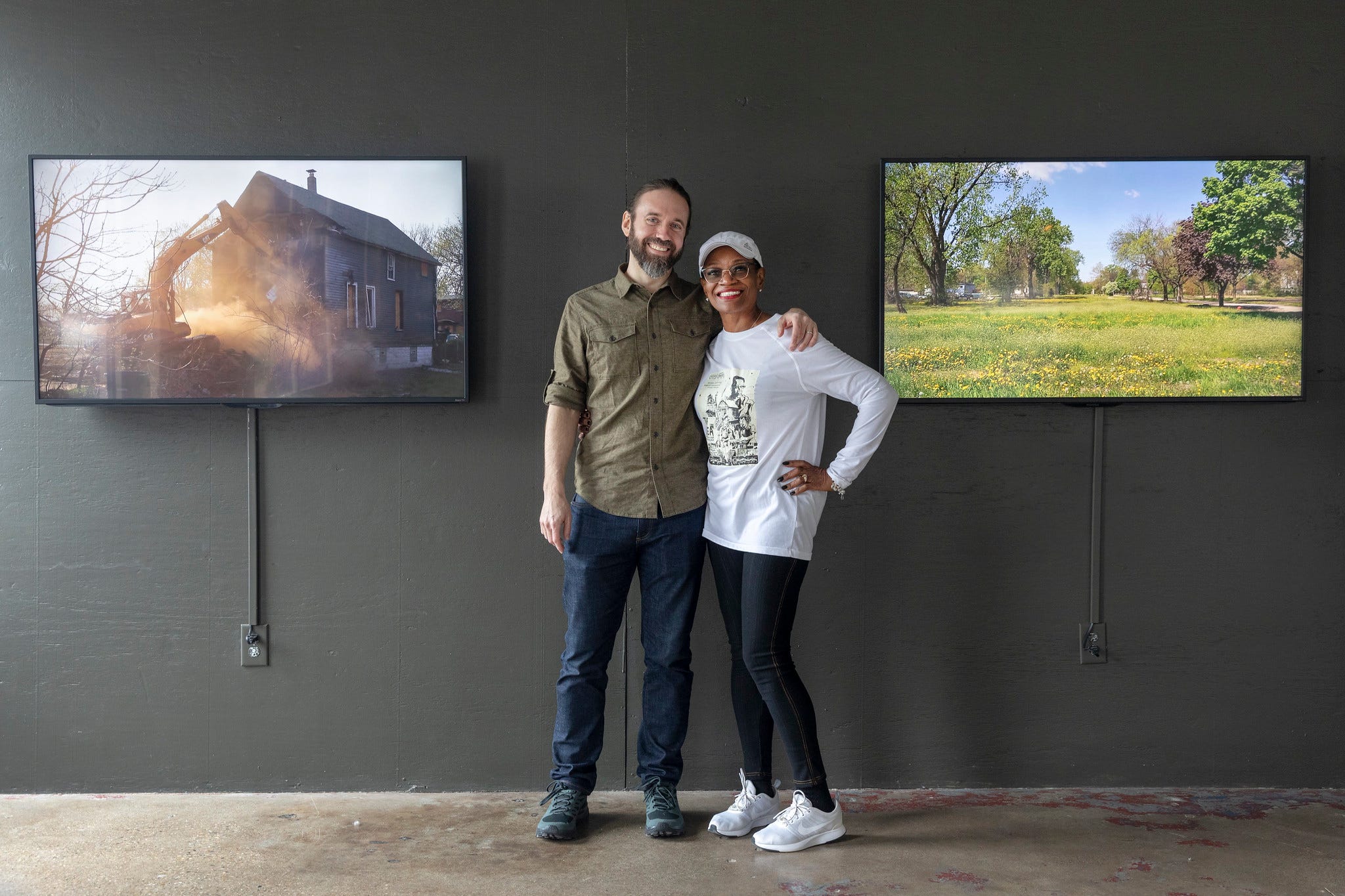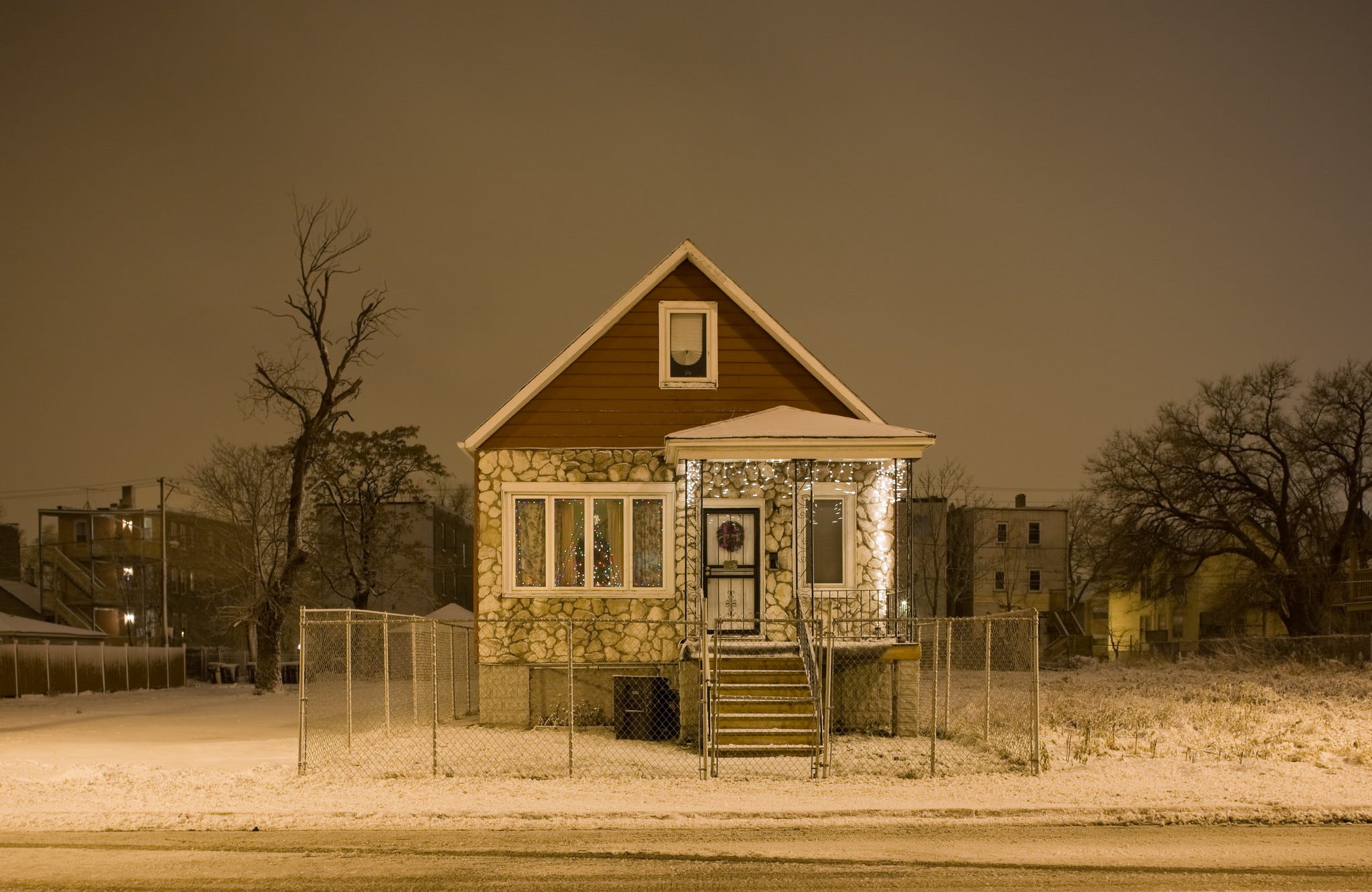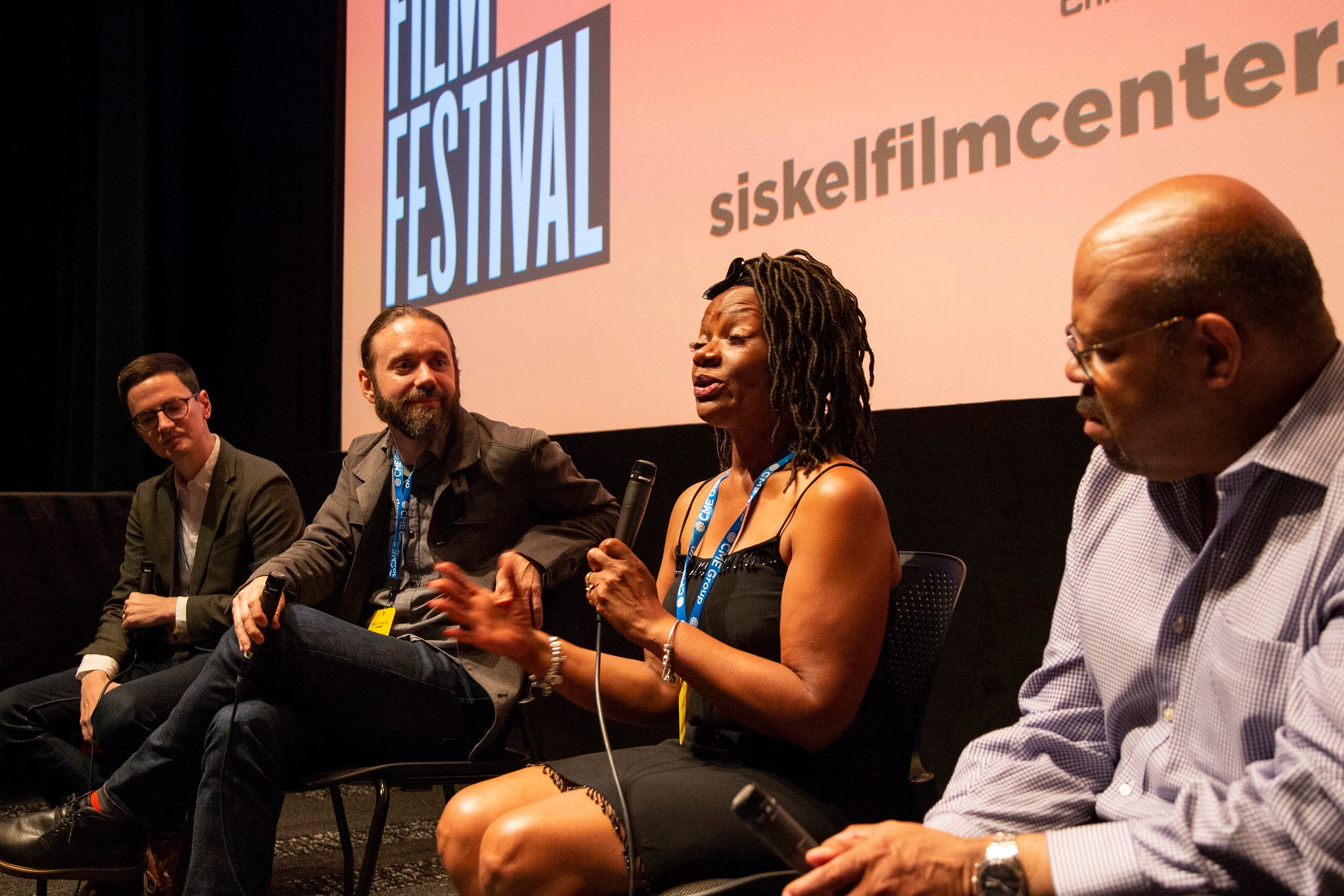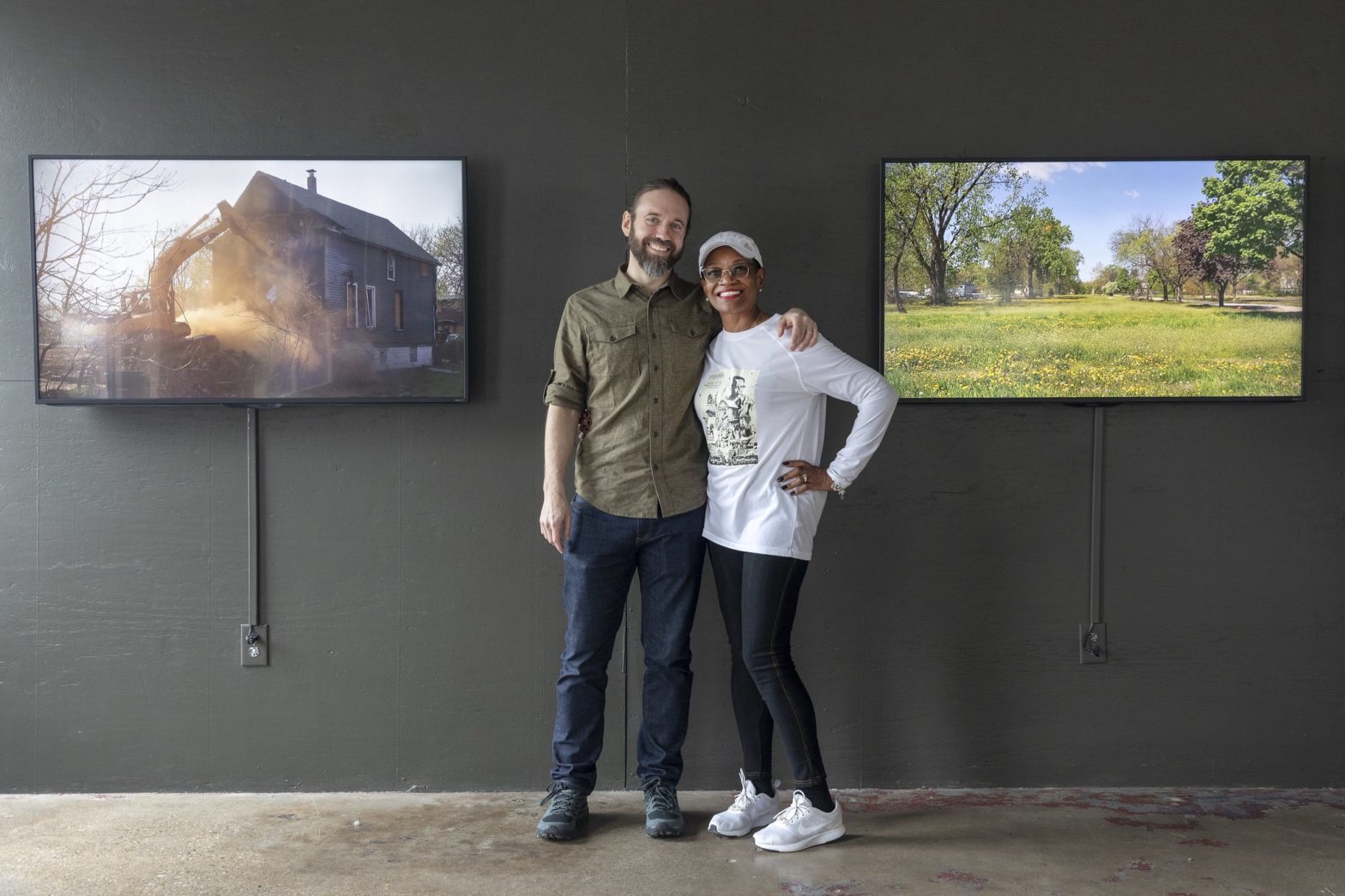Inside THE AREA: Photo project-turned feature film-turned social justice movement. David and Deborah talk documentary and community approach, presence, and follow-through.

David Schalliol and Deborah Payne carry a unique Director/Subject relationship on- and off-screen in the wake of social justice documentary THE AREA (2018), which they co-produced with Brian Ashby. This film chronicles Deborah’s five-year struggle against displacement by a multi-billion dollar freight company, exposing a community’s strength and fragility on Chicago’s South Side.
The visual sociologist and community activist spoke about their relationship during a class visit with undergraduate students at Columbia College Chicago who were starting a community-based photo project.
This conversation has been edited for length and clarity.
DEBORAH: People always ask me, “What do you do?” And I generally say “I’m just a nosy neighbor. I just get into business when things don’t look right. I want to know why they don’t look right or they don’t look normal.” My Mom used to say, “Most kids bring stray cats and dogs home. Deborah always brings stray people.”
When I met David, he was doing a project about vacancies in the neighborhood, and he stumbled upon my community. He called people, asking who was the best person to get in contact with — So they say “It’s this nosy old lady named Deborah and she might be of help. She knows everybody.”
So he just had to call me. And at the time he called me, I was very busy because I was trying to find out why the train company wanted our neighborhood.
STUDENT: So how did you start the process?
DAVID: I’d been working on a project for about a year in the neighborhood looking at development in a more abstract way — Isolated Building Studies.

And there’s a program called the Fast Track Abatement Program, which was designed as a sort of rapid way to demolish vacant buildings in the city. I was looking at such buildings all over the city and then just started to spend more time in Englewood, and noticed that it wasn’t just one or two buildings that were part of this program, becoming derelict and then getting knocked down. There were others. And no one was really talking about it outside the neighborhood.
We’re talking about displacing hundreds of families. Wrigley Field was changing the size of its scoreboard and there were hundreds of articles about it, right? But this displacement hardly moved the needle. It just seemed like it was really important.
STUDENT: Why did they pick that area specifically?
DAVID: One factor in all of this is that the financial crisis had just happened a few years before, and it was particularly felt on the South Side of Chicago because of predatory lending. The banks foreclosed on properties, and they would kick residents out, at which point scrappers and other people would come in and basically destroy the investments. In the chaos, the banks ultimately didn’t care about the house value. It was the perfect opportunity for the train company to come in and take advantage of the community.
DEBORAH: That’s the thing I fight the most. And what made me the angriest was the lack of respect. You know, you still take my taxes, still take my water bill. You still do all of these things that you do to anybody else that has a home, you know, and you just gonna disrespect me. Gonna come and tear down the house. Don’t water down [the demolition]. You don’t turn off the gas. We’re going through heck to live there. The whole thing was disrespectful. And that was my biggest thing. Respect, respect. You gonna respect me. I’m not doing nothing until you do this, you know?

DAVID: And so, that’s right around the time that Deborah and I met. I would spend a lot of time in the neighborhood talking to people on the street and hanging out in people’s homes. But really it was important to me — particularly as an outsider and as this white guy who is also involved with the University of Chicago, which has this really fraught history with the South Side of Chicago — it was all the more important to me that I find people in the neighborhood to connect with to make sure that it made sense to do a project. It needed to be coming from the neighborhood. And so I talked to everyone; I talked to ministers; I talked to other community people and the city, and everyone said I should talk to Deborah Payne. Yeah, I called her up!
DEBORAH: I have a question, David. When you called me the first time, did you have documentary on your mind then?
DAVID: I knew that something was on my mind, a bigger project than just a one-off kind of thing. But I don’t think it was a documentary yet. I knew I wanted to spend more time in the neighborhood, but I was still thinking about what the project might be.
Before it could be a documentary, we had to make sure that there was actual community interest in doing it. If you had said “no,” I would have known that that wasn’t a possibility. You know what I mean? It was just so clear that you were one of the key people who needed to be involved.
DEBORAH: So I was like, “Well, what do you want?” I told him, “Well, I’m in the community every day, you can come catch up with me.” And that’s what he did.
DEBORAH: So when did you feel comfortable with me?
DAVID: That’s a good question. I felt comfortable with you pretty quickly, in part because you exuded energy and honesty, and you’re just so personable. You speak your mind in a way that it’s clear what you’re thinking. I knew right off the bat that I could trust you.
DEBORAH: I think I got more relaxed with David more relaxed the community got with David. The young kids knew him and stuff, like “What up, David?” And I was like, “You know David?” And they’re like, “Yeah! I know with the last name with the “S,” whatever it is.” “You didn’t mean the little white boy with the ponytail?” And they said, “Yeah, I like him!”
We were together maybe about three or four months, and I was asking, “Are you sure you’re not part of the railroad?”
DAVID: (Laughs) She really would.
DEBORAH: I think I fell in love with his picture-taking ability, because he would take pictures of things that I had to complain about, and the pictures were so crisp and so unique and so detailed, and he would send them to me. By the time I got in the house, they were on my phone, and I’m like, “Oh my goodness.” So I start sending to the alderman or whoever I needed to complain all these good pictures. And they were like, “Wow…”
So David hung with me. He was always there. He always told the truth. He said “I’ll be there at nine o’clock.” He was always there at nine o’clock. So after taking all these marvelous pictures, and he and I talking all the time, he says, “I’d like to mic you up.” And I was like: “Mic me up?” What does that mean?”
I’m walking through the neighborhood and people seeing me and him with this camera and this white man following me. And some of them run in the way “I want to be in it! Come over here. Deborah, I want to be in that!” And some of em said, “Can he take a picture of us and rapping?” And whatever, you know. So he got to the people in the community felt so safe with David, and he was so honest to us. And I actually began to like David as a part of my family. It got so that I was looking for David to come mic me up. Because I had something to really fuss about today.
It wasn’t fair what [Norfolk] was doing. And he said, “Well, what are you gonna do?” I’m like, “I’m gonna fight. I’m gonna fight for the people until we have to go.” It was a done deal. And I knew that ultimately we had to leave, but everybody needed to have a complete understanding and should be able to negotiate for themselves. Some people call it the underdogs, but I call it the people that really want to do better. The strugglers, or whatever. There I am.
I wanted to bring him in, because it’s an interesting project about making connections. This is how I interpret it anyway, making connections and also forming a strong collaboration between a practitioner and a citizen. There’s five or six years of connection now.
DAVID: For me, there was a lot of that hope and excitement right in our initial interactions and the same thing with everyone else in the neighborhood. But at the same time I was worried, “Am I going to do something wrong? Am I going to screw this up somehow?” Not just screw up the project, but screw up a relationship, you know? And the longer it went, I think I didn’t worry as much about screwing up the relationship. But I think it became clearer to me how deeply involved I was in the neighborhood.
Something that I really was trying to think a lot about was how many ways I can demonstrate my continued commitment to the neighborhood over this multi-year journey. One small thing was I made family portraits for people. To this day, a couple of the families still have like big family group portraits I made of them on their walls. You know, and I think that’s a sign of a kind of enduring effect.
I think one other thing that’s important is I made a commitment from the very beginning. Once we started, we figured out this was going to work, that I was going to see this thing through. It took us about six years before things ended up the way they did.

STUDENT: Was there anyone who didn’t want to be filmed? How did you approach new subjects?
DAVID: In addition to what we talked about before, if I’m going to walk up to someone, or if I’m on a particular street for the first time, I ensure the camera isn’t in front of me. The camera is always turned off and on my side.
It’s all about approaching people before they have the opportunity to approach you. You don’t want them to worry about what you’re doing on their block, right? You want to introduce yourself and just be straightforward, and you say, like, “Is it cool if we do this?” And if they say, “no,” then, it’s “Thanks so much! I totally appreciate it. Have a great day!” You leave at that point. I’ve had a few times where people have been upset with my presence — particularly me pulling up in my Volvo, right?
Because it’s not your space, it’s theirs. And so that’s the thing I’m always carrying with me.
It’s always about being deliberate. Another small example of many: Sometimes I don’t need to shoot with a tripod, but I’ll still get a tripod out because it’s another signifier of the fact that “I’m here.” I’m clearly not hiding anything.
DEBORAH: I was so impressed with his camera, I had to get a camera. I’m just hearing what you’re saying, and I understand what you’re explaining, because once I started actually taking pictures and I would go in neighborhoods and they’ll say, “What are you doing with that camera? What’re you taking that picture for? You going to put that on Facebook, girl? I don’t play none of that. Uh-uh.. Delete that. Did you take a picture of me? Don’t take no picture of my baby.”
You know, you hear all that kind of stuff, they think that you’re up to something or you going to sell something. And so yeah, I can understand that. Generally I got a lingo, “My name is Deborah Payne, and I’m from Englewood, and I’m photographing this and that.” If they don’t want to take a picture, I’ll just go the other direction, you know?
DAVID: Now I guess I can do more with my phone, but I used to have a small book of 5”x7” photographs that I had with me that I could just show people. They were just Walgreens prints. I would show them to people so they had a sense of what I was interested in, what I was doing.
DEBORAH: When you’re driving with him, he’s always like “Aah-look at that!” Come here, come here! You see that?” So yeah, I guess people would ask you a lot — like “What are you doing outside my house?”
DAVID: And that’s a fair question, and honestly, the kind of question that we [photographers and filmmakers, like the students in the classroom] need to be prepared to answer and ideally — to be able to preemptively answer for people.
STUDENT: How do you credit a documentary subject for their involvement?
DAVID: If you look at the poster, it says “Produced by Brian Ashby, Deborah Payne, and David Schalliol.” We came to this realization that Deborah was one of the strongest producers, if not the strongest on the project. She’s calling me up and saying, “Hey, this thing’s going on, we need to get this down.”
That’s what a producer does. She’s stoking conversations and organizing what’s happening. The people you’re working with — photographic subjects or whatever — are people who are co-creating the project with you. They’re allowing you into their lives.
But even more than that, they are playing an active role and directing what’s actually happening.
I think that’s become a really important part of the message of the film. She’s a Producer and the Protagonist.
DEBORAH: It took me a while to understand what it meant to be to the Producer. That just sounded like a big shot thing, you know, and I don’t want my name up there that because then they’re going to ask bigger questions and use bigger words. After maybe the 16th time that I was on a panel, I said, you know what? This is pretty easy.
All I gotta do is show up and tell the truth, just whatever they asked me, just tell the truth and it’s not hard.


PROFESSOR: So the neighborhood is gone, now. What did you take away from it all?
DEBORAH: What’s so precious to me is not seeing me and a picture of how much I fought. It’s that this is one of the times that what has happened in an Englewood community got documented. So I was proud of that. It’s not just me going through it, not just Englewood going through it, people in Chicago and many other places outside of Chicago going through re-gentrification of some kind.
Six years had gone past and all of these days of filming in the house outside winter, snow, whatever. So I’m in North Carolina [at the Full Frame Film Festival], and I’m like “How can somebody put something like this together?” I was so involved in the film, I forgot it was me that I was looking at. There’s a part in there where I actually get sick, and I’m fown in a helicopter to the hospital, and it gets dark in the film and I said, “She died…” Then I was like, “No, she didn’t! That’s me!” I never knew that you could do so much with pictures and videos.
When I was looking at the pictures, I said “It’s hard to believe that I did that, but when your intentions are doing something that you feel is right, and you put everything in you to fight for it and you believe it, you can do all of that. But it wasn’t until last year when we went to a film festival that I felt the broader impact.
I keep on thinking he’s my son now, and lots of times when we go places and I say “c’mere David,” and I say “This is my son.” And they’re like: “Really?!”
That’s how close we’ve grown in the years and the amount of trust. He got married on me. I have a daughter-in-law, you know? We’re just so close, and it just came out of something like this, and I am really, really happy that God placed him in my life.
DAVID: Me too.


